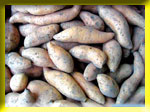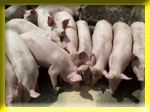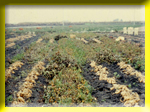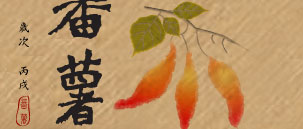





|
The Golden Years of Sweet Potato
|
| |
Sweet potato has accompanied Taiwanese to explore every inch of this island. Its expansion reached its peak during the Japanese occupation period. The 25 years from 1945 to 1970 was the golden years of sweet potato. The yield quantity was growing from 1.16 million tons to 3.44 million tons.
|

The period after World War II was the golden years of Taiwan's sweet potato
|
|
|
| |
| |

Photos of winners of sweet potato yields contest
|
The main reason to reach the peak was caused by the blooming of the husbandry industry. During the period of 1950 and 1960, it was very common to raise pigs in the countryside. At that time, the Food Bureau promoted yield increase cycle: sundry provisions planting, pig raising, and rice planting. It encouraged farmers to plant sundry provisions such as sweet potato during fallow to fee pigs. Dung of pigs was the best muck to improve soil for planting rice. |
|
|
| |
| |
Taiwanese people did not decrease the yield volume of sweet potato as a result of its role change from human food to pig's feedstuff. The yield volume of food sweet potato was decreasing year by year, whereas that of feedstuff sweet potato was increasing by 50%. It also supported government's policy of 「Developing industry on the basis of agriculture」 which accelerated the economic growth of this country.
|

The prosperity of livestock husbandry supported government's policy of 「Developing industry with agriculture」
|
|
|
| |
| |

Sweet potato created good opportunity for powder industry |
Besides, the government took up measures in controlling the importation of starch and sundry provisions to reduce unnecessary foreign exchange loss. This move unexpectedly turned out to be the cause of yield increase of sweet potato. Being protected, the industry of powder such as sweet potato powder and cassava powder had room for development. Nevertheless, once the consideration of reducing foreign exchange loss is moved, the bloom of sweet potato caused by this reason would be gone.
|
|
|
| |
| |
The achievement sweet potato after World War II was ascribed to two factors: planting area expansion and unit area yield. The planting area in 1946 was 170000 hectares, which was higher than the record in the Japanese occupation period. In 1954, it was expanded to 240000 hectares. The planting area of sweet potato was greatly increased that inevitably squeezed the planting area of the sugar cane. The importance of sugar cane was significantly declined after the war. The demand for rice and sweet potato was higher than that of sugar cane. Consequently, the planting areas of sugar cane in Yunlin, Jiayi, Tainan were replaced by that of sweet potato. |

The planting area of sweet potato greatly replaced that of sugar cane
|
|
|
| |
| |
The highest yield record in the Japanese ruling period was 13000 kilos per hectare in 1937. Because of the common use of fertilizers, the yield easily reached this level in 1961. The economic environments after war was 「Developing industrial on the basis of agriculture」, rice exporting, promising livestock husbandry, importation control, foreign exchange consideration, and planting species change. These were the direct or indirect factors for yield increase of sweet potato. These factors, just like the stage, the backgrounds, the lighting, the music of an opera, jointly performed with sweet potato a wonderful play of "Golden Years of Sweet Potato".
|
|
|
| |
| |
|
|
|
|
|




